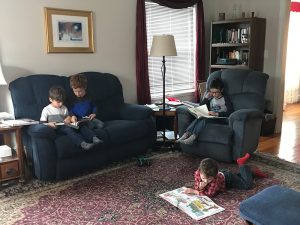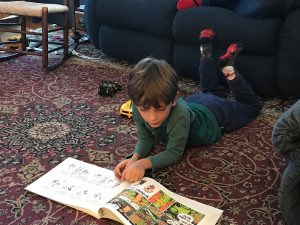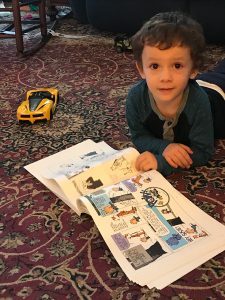For Love of Calvin & Hobbes
 This past Christmas my daughter, her husband, and four sons all isolated themselves for two weeks so that they could visit us safely for the holiday. Thankfully, no one got sick in that time. It was still a more restrained Christmas, with fewer activities and visitors than in a normal year, but we were thrilled to be able to have them with us for a couple of weeks.
This past Christmas my daughter, her husband, and four sons all isolated themselves for two weeks so that they could visit us safely for the holiday. Thankfully, no one got sick in that time. It was still a more restrained Christmas, with fewer activities and visitors than in a normal year, but we were thrilled to be able to have them with us for a couple of weeks.
The nine-year-old is a proficient and voracious reader. The seven-year-old reads well enough, though he’d rather be building things, and the five-year-old has made a good start. Even the three-year-old enjoys looking through books. We try to have a good supply of age-appropriate literature around for them.
 But, in fact, the overall favorite books for all of the boys is their Grandad’s treasured set of Calvin and Hobbes books. Their love for those books is so strong, permission to read them serves as a reward – they’re allowed to look at them only after cleaning up all the toys they’ve left scattered across the floor and every other available surface.
But, in fact, the overall favorite books for all of the boys is their Grandad’s treasured set of Calvin and Hobbes books. Their love for those books is so strong, permission to read them serves as a reward – they’re allowed to look at them only after cleaning up all the toys they’ve left scattered across the floor and every other available surface.
Even the three-year-old, who doesn’t read yet (as far as we know), seems to adore them and will look at the pictures for as long as he’s allowed. I’m not actually surprised. Some of the appeal has to be the marvelously adorable drawings, which are detailed and expressive enough to tell stories on their own.
The older boys will giggle, laugh, and frequently bring certain strips to adult attention, reading the dialogue out loud while attempting to contain their amusement long enough to get the words out.
 They understand and appreciate Calvin’s wry sarcasm and wild imagination on some levels. The adventures of Spaceman Spiff and his other imaginary alter egos tend to be favorites. They ‘get’ that many of Calvin’s imaginary scrapes are mirroring real-life unpleasant situations. And they seem to understand that Calvin is using his flights of whimsy as a way of dealing with a world over which, as a child, he has very little control, though of course, they haven’t the words to explain it.
They understand and appreciate Calvin’s wry sarcasm and wild imagination on some levels. The adventures of Spaceman Spiff and his other imaginary alter egos tend to be favorites. They ‘get’ that many of Calvin’s imaginary scrapes are mirroring real-life unpleasant situations. And they seem to understand that Calvin is using his flights of whimsy as a way of dealing with a world over which, as a child, he has very little control, though of course, they haven’t the words to explain it.
I can see aspects of each boy’s personality in Calvin. The oldest is probably the most similar. From a small child his favorite companion animal has been “Mr. Monkey.” By the time he was able to read (he taught himself to read somewhere around his third birthday) and began to expand his world, he also began to make up stories about Mr. Monkey and his adventures. Those finally expanded into “Monkeyland,” a huge and richly detailed world that occupied much of his thoughts for many years.
His next brother, the seven-year-old is more physically oriented than his brother, but still has a rich and vivid imagination. His favorite stuffed animal companion is a bear and we’ve heard many adventures in “Bearland.” But he’s also the kid who shimmies up doorways and will climb anything he can reach. Any tree that has a foothold he can get to, sometimes with the help of porch furniture, other play equipment, or even his bike, is fair game. He’s the kid who climbs on top of the playground equipment. When it comes to heights, he’s fearless. Calvin on his madcap sled-rides and in his treehouse remind me of him.
The five-year-old is the charmer of the family. He resembles Calvin in his very definite opinions, expressed with great confidence. If anyone in the family would conduct a survey on Dad’s popularity with the younger set, it would be him.
The three-year-old… I don’t know. He’s a bit too young to call. On the other hand, for the last year or more, he’s been insisting he’s a cat and will frequently meow. Yet he does it with a sly little grin as he clutches the stuffed kitty-cat that is his favorite companion animal.
As an adult I still love reading the comics, too. There’s something both gloriously innocent and wryly wise about Calvin that reminds me of just how broad the world can be. And it reminds me that as a kid I created and explored strange lands in my own imagination. In my writing, I try to continue to do so, struggling to shake off some of the limitations decades of dealing with the real world has tried to impose.
By sheer coincidence, while I was writing this post, I happened on this story in the Washington Post that makes some of the same observations, but talks more about the universal appeal in ways I hadn’t considered:
